Role of the Teacher in the Lifelong Learning Sector: An Analysis
VerifiedAdded on 2022/09/05
|11
|2955
|28
Essay
AI Summary
This essay provides a comprehensive analysis of the role of teachers in the lifelong learning sector. It begins with an introduction to lifelong learning and its significance, followed by an examination of the responsibilities of teachers, including promoting equality and understanding learner competencies. The essay delves into key concepts and theories underpinning the planning, delivery, and assessment of learning, such as cognitivism and constructivism, highlighting their relevance to lifelong learning. It also explores classroom management strategies, emphasizing the importance of creating a positive and inclusive learning environment. The discussion includes potential issues in group dynamics and the use of technology. Overall, the essay underscores the multifaceted role of teachers in fostering effective and inclusive lifelong learning experiences.
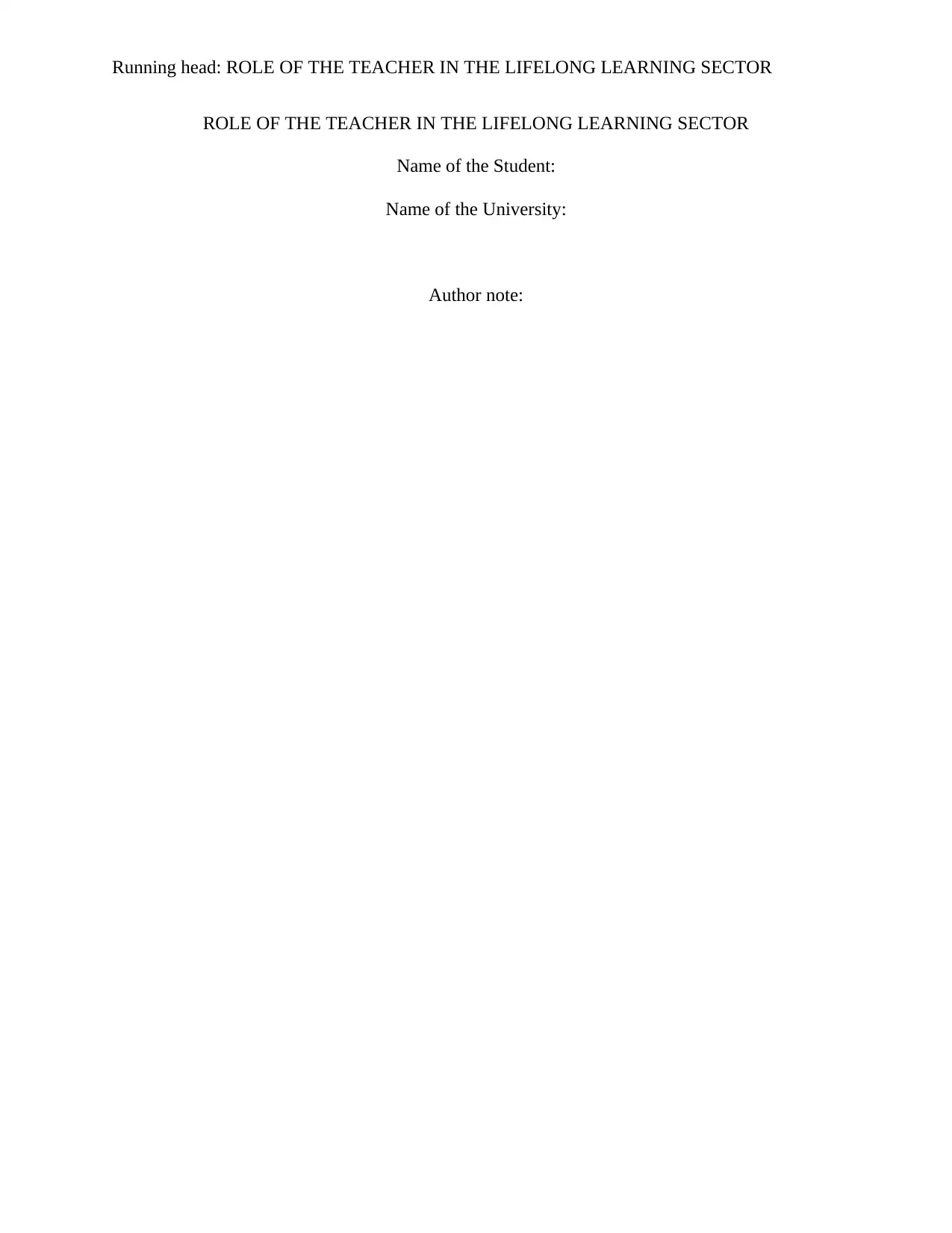
Running head: ROLE OF THE TEACHER IN THE LIFELONG LEARNING SECTOR
ROLE OF THE TEACHER IN THE LIFELONG LEARNING SECTOR
Name of the Student:
Name of the University:
Author note:
ROLE OF THE TEACHER IN THE LIFELONG LEARNING SECTOR
Name of the Student:
Name of the University:
Author note:
Paraphrase This Document
Need a fresh take? Get an instant paraphrase of this document with our AI Paraphraser
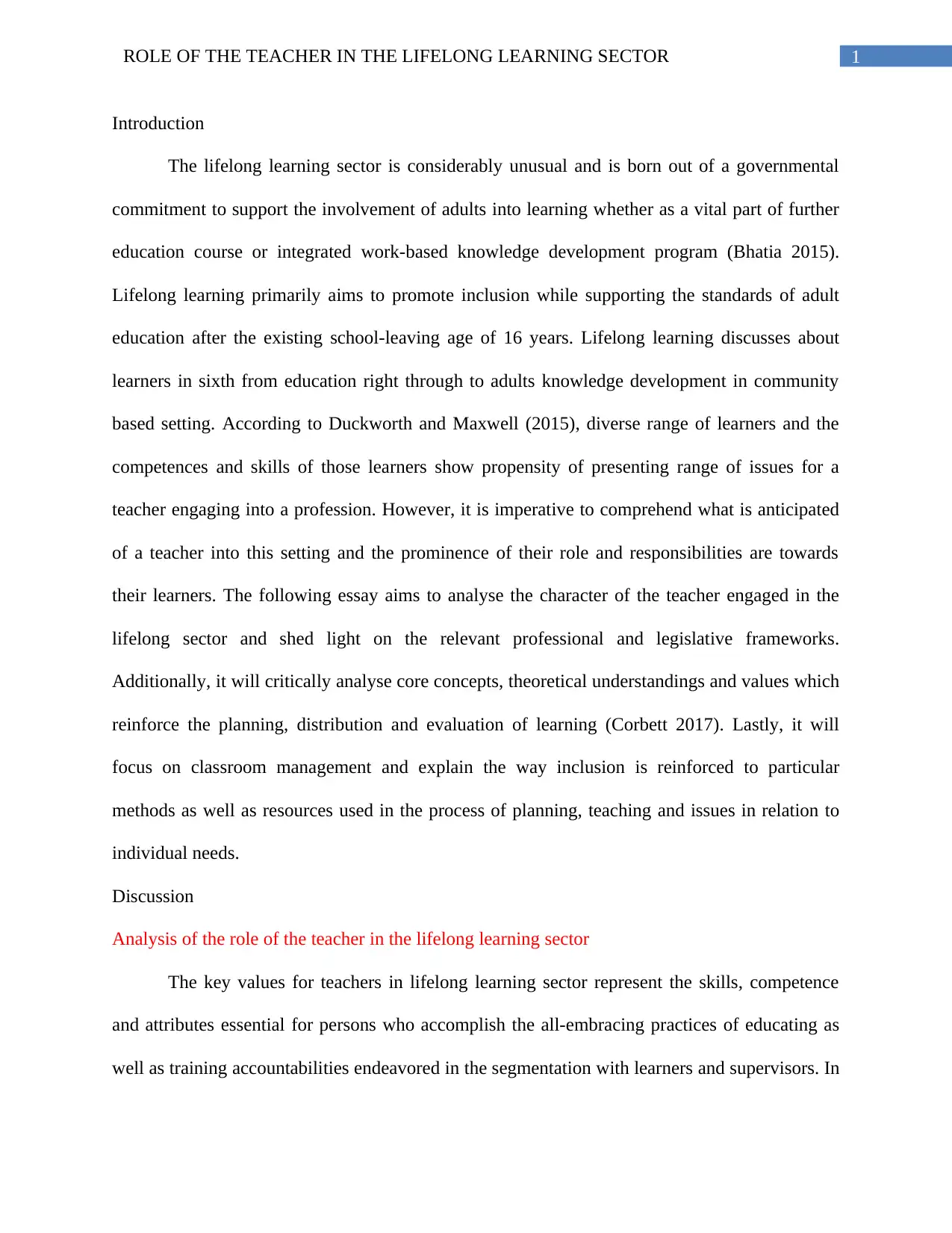
1ROLE OF THE TEACHER IN THE LIFELONG LEARNING SECTOR
Introduction
The lifelong learning sector is considerably unusual and is born out of a governmental
commitment to support the involvement of adults into learning whether as a vital part of further
education course or integrated work-based knowledge development program (Bhatia 2015).
Lifelong learning primarily aims to promote inclusion while supporting the standards of adult
education after the existing school-leaving age of 16 years. Lifelong learning discusses about
learners in sixth from education right through to adults knowledge development in community
based setting. According to Duckworth and Maxwell (2015), diverse range of learners and the
competences and skills of those learners show propensity of presenting range of issues for a
teacher engaging into a profession. However, it is imperative to comprehend what is anticipated
of a teacher into this setting and the prominence of their role and responsibilities are towards
their learners. The following essay aims to analyse the character of the teacher engaged in the
lifelong sector and shed light on the relevant professional and legislative frameworks.
Additionally, it will critically analyse core concepts, theoretical understandings and values which
reinforce the planning, distribution and evaluation of learning (Corbett 2017). Lastly, it will
focus on classroom management and explain the way inclusion is reinforced to particular
methods as well as resources used in the process of planning, teaching and issues in relation to
individual needs.
Discussion
Analysis of the role of the teacher in the lifelong learning sector
The key values for teachers in lifelong learning sector represent the skills, competence
and attributes essential for persons who accomplish the all-embracing practices of educating as
well as training accountabilities endeavored in the segmentation with learners and supervisors. In
Introduction
The lifelong learning sector is considerably unusual and is born out of a governmental
commitment to support the involvement of adults into learning whether as a vital part of further
education course or integrated work-based knowledge development program (Bhatia 2015).
Lifelong learning primarily aims to promote inclusion while supporting the standards of adult
education after the existing school-leaving age of 16 years. Lifelong learning discusses about
learners in sixth from education right through to adults knowledge development in community
based setting. According to Duckworth and Maxwell (2015), diverse range of learners and the
competences and skills of those learners show propensity of presenting range of issues for a
teacher engaging into a profession. However, it is imperative to comprehend what is anticipated
of a teacher into this setting and the prominence of their role and responsibilities are towards
their learners. The following essay aims to analyse the character of the teacher engaged in the
lifelong sector and shed light on the relevant professional and legislative frameworks.
Additionally, it will critically analyse core concepts, theoretical understandings and values which
reinforce the planning, distribution and evaluation of learning (Corbett 2017). Lastly, it will
focus on classroom management and explain the way inclusion is reinforced to particular
methods as well as resources used in the process of planning, teaching and issues in relation to
individual needs.
Discussion
Analysis of the role of the teacher in the lifelong learning sector
The key values for teachers in lifelong learning sector represent the skills, competence
and attributes essential for persons who accomplish the all-embracing practices of educating as
well as training accountabilities endeavored in the segmentation with learners and supervisors. In
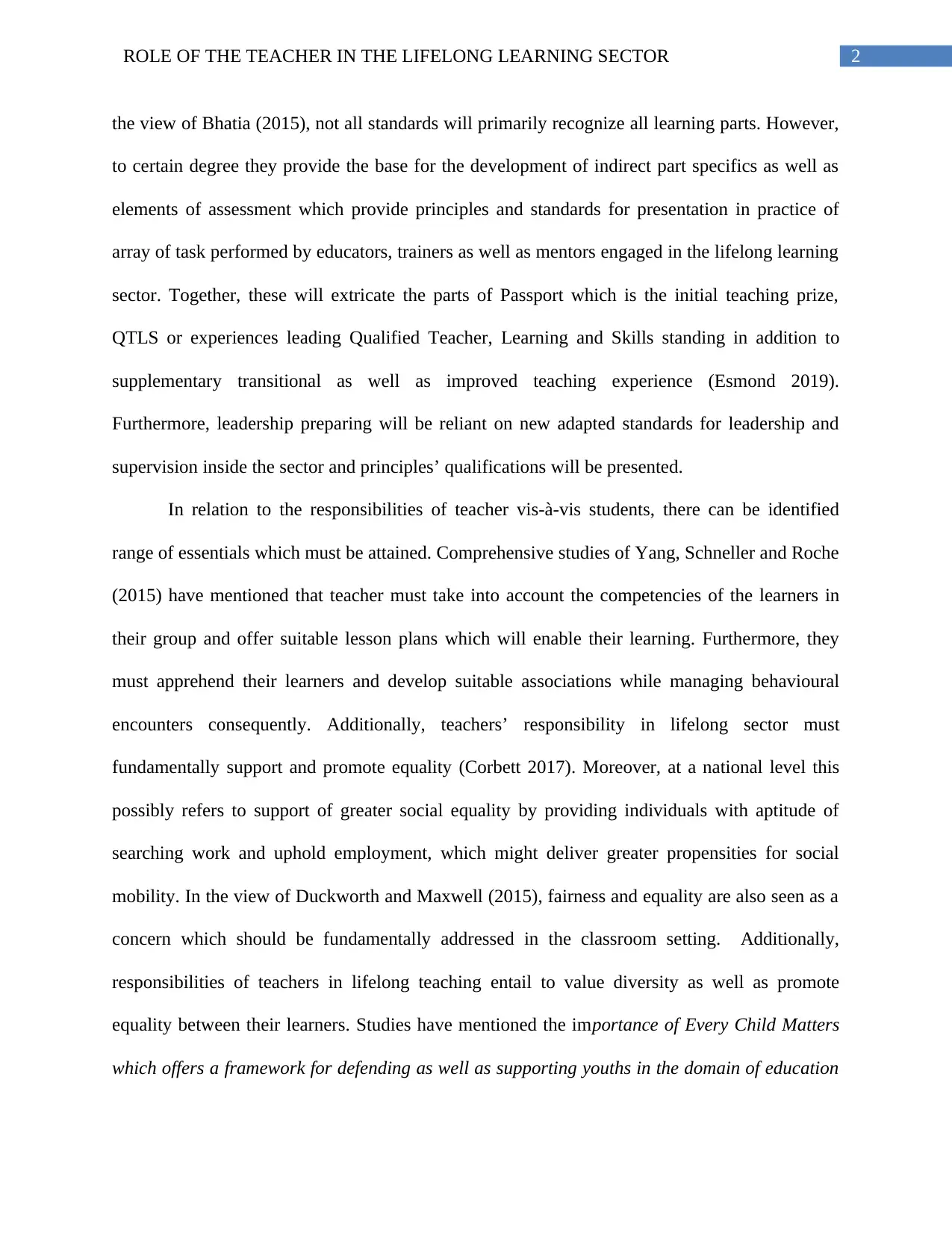
2ROLE OF THE TEACHER IN THE LIFELONG LEARNING SECTOR
the view of Bhatia (2015), not all standards will primarily recognize all learning parts. However,
to certain degree they provide the base for the development of indirect part specifics as well as
elements of assessment which provide principles and standards for presentation in practice of
array of task performed by educators, trainers as well as mentors engaged in the lifelong learning
sector. Together, these will extricate the parts of Passport which is the initial teaching prize,
QTLS or experiences leading Qualified Teacher, Learning and Skills standing in addition to
supplementary transitional as well as improved teaching experience (Esmond 2019).
Furthermore, leadership preparing will be reliant on new adapted standards for leadership and
supervision inside the sector and principles’ qualifications will be presented.
In relation to the responsibilities of teacher vis-à-vis students, there can be identified
range of essentials which must be attained. Comprehensive studies of Yang, Schneller and Roche
(2015) have mentioned that teacher must take into account the competencies of the learners in
their group and offer suitable lesson plans which will enable their learning. Furthermore, they
must apprehend their learners and develop suitable associations while managing behavioural
encounters consequently. Additionally, teachers’ responsibility in lifelong sector must
fundamentally support and promote equality (Corbett 2017). Moreover, at a national level this
possibly refers to support of greater social equality by providing individuals with aptitude of
searching work and uphold employment, which might deliver greater propensities for social
mobility. In the view of Duckworth and Maxwell (2015), fairness and equality are also seen as a
concern which should be fundamentally addressed in the classroom setting. Additionally,
responsibilities of teachers in lifelong teaching entail to value diversity as well as promote
equality between their learners. Studies have mentioned the importance of Every Child Matters
which offers a framework for defending as well as supporting youths in the domain of education
the view of Bhatia (2015), not all standards will primarily recognize all learning parts. However,
to certain degree they provide the base for the development of indirect part specifics as well as
elements of assessment which provide principles and standards for presentation in practice of
array of task performed by educators, trainers as well as mentors engaged in the lifelong learning
sector. Together, these will extricate the parts of Passport which is the initial teaching prize,
QTLS or experiences leading Qualified Teacher, Learning and Skills standing in addition to
supplementary transitional as well as improved teaching experience (Esmond 2019).
Furthermore, leadership preparing will be reliant on new adapted standards for leadership and
supervision inside the sector and principles’ qualifications will be presented.
In relation to the responsibilities of teacher vis-à-vis students, there can be identified
range of essentials which must be attained. Comprehensive studies of Yang, Schneller and Roche
(2015) have mentioned that teacher must take into account the competencies of the learners in
their group and offer suitable lesson plans which will enable their learning. Furthermore, they
must apprehend their learners and develop suitable associations while managing behavioural
encounters consequently. Additionally, teachers’ responsibility in lifelong sector must
fundamentally support and promote equality (Corbett 2017). Moreover, at a national level this
possibly refers to support of greater social equality by providing individuals with aptitude of
searching work and uphold employment, which might deliver greater propensities for social
mobility. In the view of Duckworth and Maxwell (2015), fairness and equality are also seen as a
concern which should be fundamentally addressed in the classroom setting. Additionally,
responsibilities of teachers in lifelong teaching entail to value diversity as well as promote
equality between their learners. Studies have mentioned the importance of Every Child Matters
which offers a framework for defending as well as supporting youths in the domain of education
⊘ This is a preview!⊘
Do you want full access?
Subscribe today to unlock all pages.

Trusted by 1+ million students worldwide
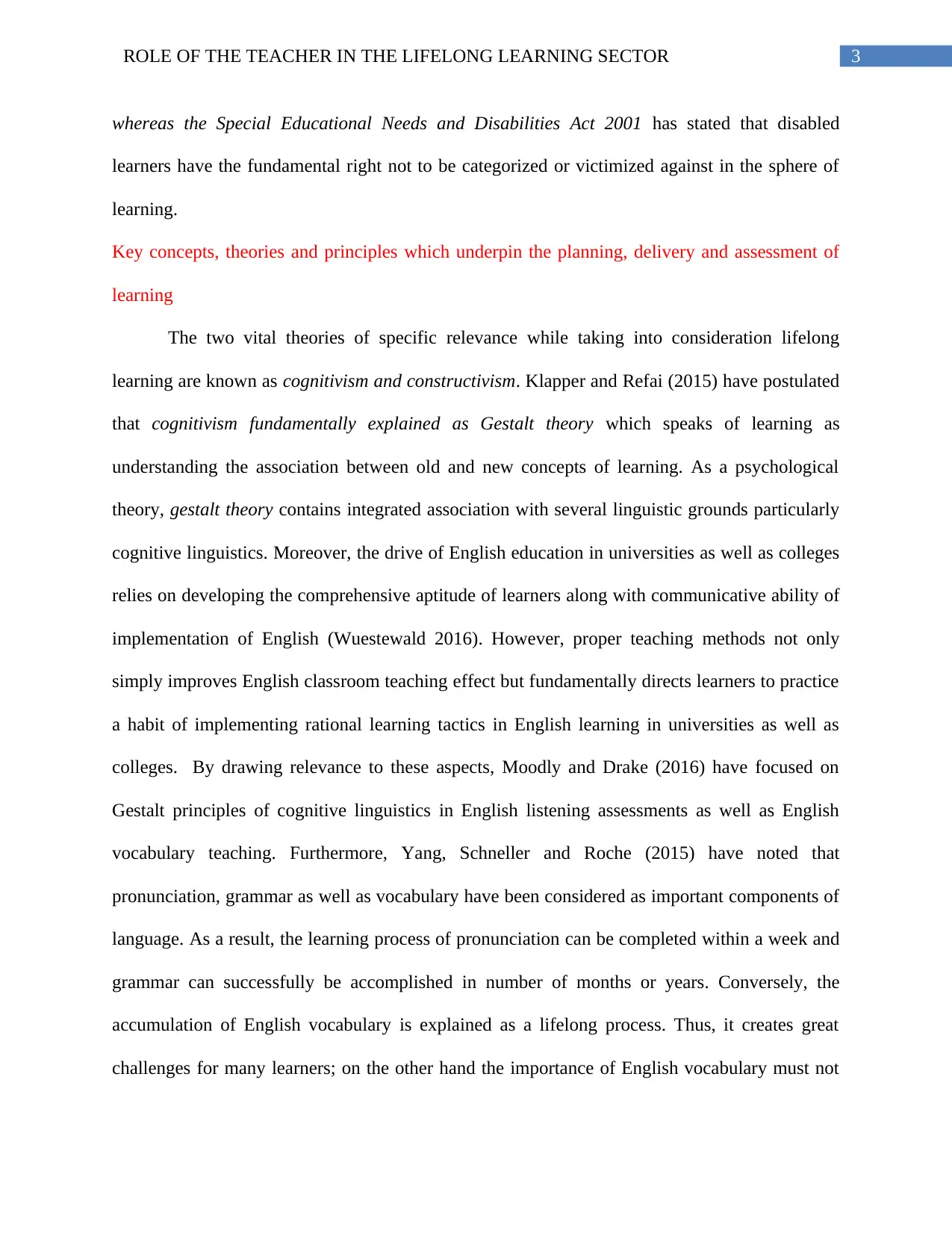
3ROLE OF THE TEACHER IN THE LIFELONG LEARNING SECTOR
whereas the Special Educational Needs and Disabilities Act 2001 has stated that disabled
learners have the fundamental right not to be categorized or victimized against in the sphere of
learning.
Key concepts, theories and principles which underpin the planning, delivery and assessment of
learning
The two vital theories of specific relevance while taking into consideration lifelong
learning are known as cognitivism and constructivism. Klapper and Refai (2015) have postulated
that cognitivism fundamentally explained as Gestalt theory which speaks of learning as
understanding the association between old and new concepts of learning. As a psychological
theory, gestalt theory contains integrated association with several linguistic grounds particularly
cognitive linguistics. Moreover, the drive of English education in universities as well as colleges
relies on developing the comprehensive aptitude of learners along with communicative ability of
implementation of English (Wuestewald 2016). However, proper teaching methods not only
simply improves English classroom teaching effect but fundamentally directs learners to practice
a habit of implementing rational learning tactics in English learning in universities as well as
colleges. By drawing relevance to these aspects, Moodly and Drake (2016) have focused on
Gestalt principles of cognitive linguistics in English listening assessments as well as English
vocabulary teaching. Furthermore, Yang, Schneller and Roche (2015) have noted that
pronunciation, grammar as well as vocabulary have been considered as important components of
language. As a result, the learning process of pronunciation can be completed within a week and
grammar can successfully be accomplished in number of months or years. Conversely, the
accumulation of English vocabulary is explained as a lifelong process. Thus, it creates great
challenges for many learners; on the other hand the importance of English vocabulary must not
whereas the Special Educational Needs and Disabilities Act 2001 has stated that disabled
learners have the fundamental right not to be categorized or victimized against in the sphere of
learning.
Key concepts, theories and principles which underpin the planning, delivery and assessment of
learning
The two vital theories of specific relevance while taking into consideration lifelong
learning are known as cognitivism and constructivism. Klapper and Refai (2015) have postulated
that cognitivism fundamentally explained as Gestalt theory which speaks of learning as
understanding the association between old and new concepts of learning. As a psychological
theory, gestalt theory contains integrated association with several linguistic grounds particularly
cognitive linguistics. Moreover, the drive of English education in universities as well as colleges
relies on developing the comprehensive aptitude of learners along with communicative ability of
implementation of English (Wuestewald 2016). However, proper teaching methods not only
simply improves English classroom teaching effect but fundamentally directs learners to practice
a habit of implementing rational learning tactics in English learning in universities as well as
colleges. By drawing relevance to these aspects, Moodly and Drake (2016) have focused on
Gestalt principles of cognitive linguistics in English listening assessments as well as English
vocabulary teaching. Furthermore, Yang, Schneller and Roche (2015) have noted that
pronunciation, grammar as well as vocabulary have been considered as important components of
language. As a result, the learning process of pronunciation can be completed within a week and
grammar can successfully be accomplished in number of months or years. Conversely, the
accumulation of English vocabulary is explained as a lifelong process. Thus, it creates great
challenges for many learners; on the other hand the importance of English vocabulary must not
Paraphrase This Document
Need a fresh take? Get an instant paraphrase of this document with our AI Paraphraser
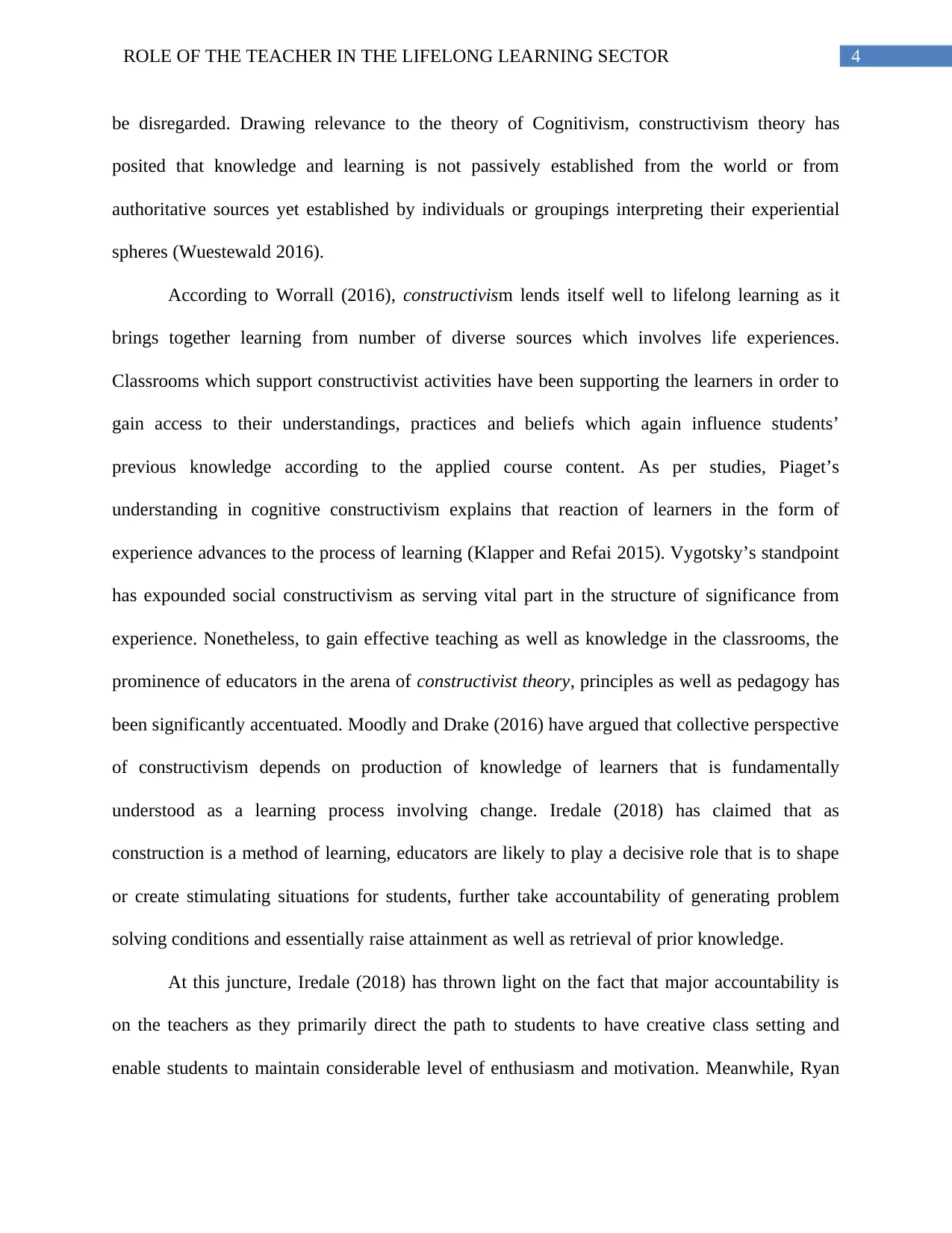
4ROLE OF THE TEACHER IN THE LIFELONG LEARNING SECTOR
be disregarded. Drawing relevance to the theory of Cognitivism, constructivism theory has
posited that knowledge and learning is not passively established from the world or from
authoritative sources yet established by individuals or groupings interpreting their experiential
spheres (Wuestewald 2016).
According to Worrall (2016), constructivism lends itself well to lifelong learning as it
brings together learning from number of diverse sources which involves life experiences.
Classrooms which support constructivist activities have been supporting the learners in order to
gain access to their understandings, practices and beliefs which again influence students’
previous knowledge according to the applied course content. As per studies, Piaget’s
understanding in cognitive constructivism explains that reaction of learners in the form of
experience advances to the process of learning (Klapper and Refai 2015). Vygotsky’s standpoint
has expounded social constructivism as serving vital part in the structure of significance from
experience. Nonetheless, to gain effective teaching as well as knowledge in the classrooms, the
prominence of educators in the arena of constructivist theory, principles as well as pedagogy has
been significantly accentuated. Moodly and Drake (2016) have argued that collective perspective
of constructivism depends on production of knowledge of learners that is fundamentally
understood as a learning process involving change. Iredale (2018) has claimed that as
construction is a method of learning, educators are likely to play a decisive role that is to shape
or create stimulating situations for students, further take accountability of generating problem
solving conditions and essentially raise attainment as well as retrieval of prior knowledge.
At this juncture, Iredale (2018) has thrown light on the fact that major accountability is
on the teachers as they primarily direct the path to students to have creative class setting and
enable students to maintain considerable level of enthusiasm and motivation. Meanwhile, Ryan
be disregarded. Drawing relevance to the theory of Cognitivism, constructivism theory has
posited that knowledge and learning is not passively established from the world or from
authoritative sources yet established by individuals or groupings interpreting their experiential
spheres (Wuestewald 2016).
According to Worrall (2016), constructivism lends itself well to lifelong learning as it
brings together learning from number of diverse sources which involves life experiences.
Classrooms which support constructivist activities have been supporting the learners in order to
gain access to their understandings, practices and beliefs which again influence students’
previous knowledge according to the applied course content. As per studies, Piaget’s
understanding in cognitive constructivism explains that reaction of learners in the form of
experience advances to the process of learning (Klapper and Refai 2015). Vygotsky’s standpoint
has expounded social constructivism as serving vital part in the structure of significance from
experience. Nonetheless, to gain effective teaching as well as knowledge in the classrooms, the
prominence of educators in the arena of constructivist theory, principles as well as pedagogy has
been significantly accentuated. Moodly and Drake (2016) have argued that collective perspective
of constructivism depends on production of knowledge of learners that is fundamentally
understood as a learning process involving change. Iredale (2018) has claimed that as
construction is a method of learning, educators are likely to play a decisive role that is to shape
or create stimulating situations for students, further take accountability of generating problem
solving conditions and essentially raise attainment as well as retrieval of prior knowledge.
At this juncture, Iredale (2018) has thrown light on the fact that major accountability is
on the teachers as they primarily direct the path to students to have creative class setting and
enable students to maintain considerable level of enthusiasm and motivation. Meanwhile, Ryan
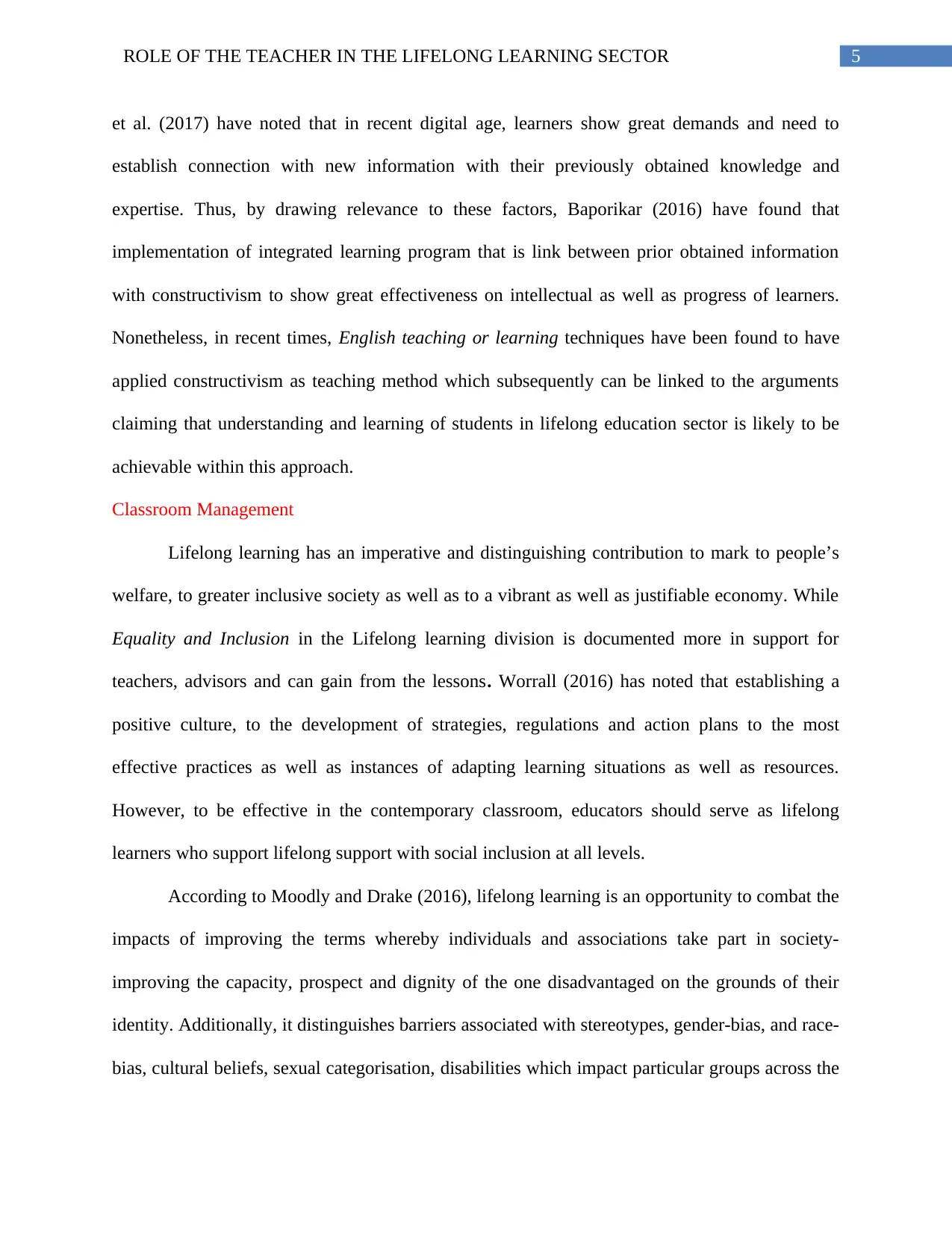
5ROLE OF THE TEACHER IN THE LIFELONG LEARNING SECTOR
et al. (2017) have noted that in recent digital age, learners show great demands and need to
establish connection with new information with their previously obtained knowledge and
expertise. Thus, by drawing relevance to these factors, Baporikar (2016) have found that
implementation of integrated learning program that is link between prior obtained information
with constructivism to show great effectiveness on intellectual as well as progress of learners.
Nonetheless, in recent times, English teaching or learning techniques have been found to have
applied constructivism as teaching method which subsequently can be linked to the arguments
claiming that understanding and learning of students in lifelong education sector is likely to be
achievable within this approach.
Classroom Management
Lifelong learning has an imperative and distinguishing contribution to mark to people’s
welfare, to greater inclusive society as well as to a vibrant as well as justifiable economy. While
Equality and Inclusion in the Lifelong learning division is documented more in support for
teachers, advisors and can gain from the lessons. Worrall (2016) has noted that establishing a
positive culture, to the development of strategies, regulations and action plans to the most
effective practices as well as instances of adapting learning situations as well as resources.
However, to be effective in the contemporary classroom, educators should serve as lifelong
learners who support lifelong support with social inclusion at all levels.
According to Moodly and Drake (2016), lifelong learning is an opportunity to combat the
impacts of improving the terms whereby individuals and associations take part in society-
improving the capacity, prospect and dignity of the one disadvantaged on the grounds of their
identity. Additionally, it distinguishes barriers associated with stereotypes, gender-bias, and race-
bias, cultural beliefs, sexual categorisation, disabilities which impact particular groups across the
et al. (2017) have noted that in recent digital age, learners show great demands and need to
establish connection with new information with their previously obtained knowledge and
expertise. Thus, by drawing relevance to these factors, Baporikar (2016) have found that
implementation of integrated learning program that is link between prior obtained information
with constructivism to show great effectiveness on intellectual as well as progress of learners.
Nonetheless, in recent times, English teaching or learning techniques have been found to have
applied constructivism as teaching method which subsequently can be linked to the arguments
claiming that understanding and learning of students in lifelong education sector is likely to be
achievable within this approach.
Classroom Management
Lifelong learning has an imperative and distinguishing contribution to mark to people’s
welfare, to greater inclusive society as well as to a vibrant as well as justifiable economy. While
Equality and Inclusion in the Lifelong learning division is documented more in support for
teachers, advisors and can gain from the lessons. Worrall (2016) has noted that establishing a
positive culture, to the development of strategies, regulations and action plans to the most
effective practices as well as instances of adapting learning situations as well as resources.
However, to be effective in the contemporary classroom, educators should serve as lifelong
learners who support lifelong support with social inclusion at all levels.
According to Moodly and Drake (2016), lifelong learning is an opportunity to combat the
impacts of improving the terms whereby individuals and associations take part in society-
improving the capacity, prospect and dignity of the one disadvantaged on the grounds of their
identity. Additionally, it distinguishes barriers associated with stereotypes, gender-bias, and race-
bias, cultural beliefs, sexual categorisation, disabilities which impact particular groups across the
⊘ This is a preview!⊘
Do you want full access?
Subscribe today to unlock all pages.

Trusted by 1+ million students worldwide
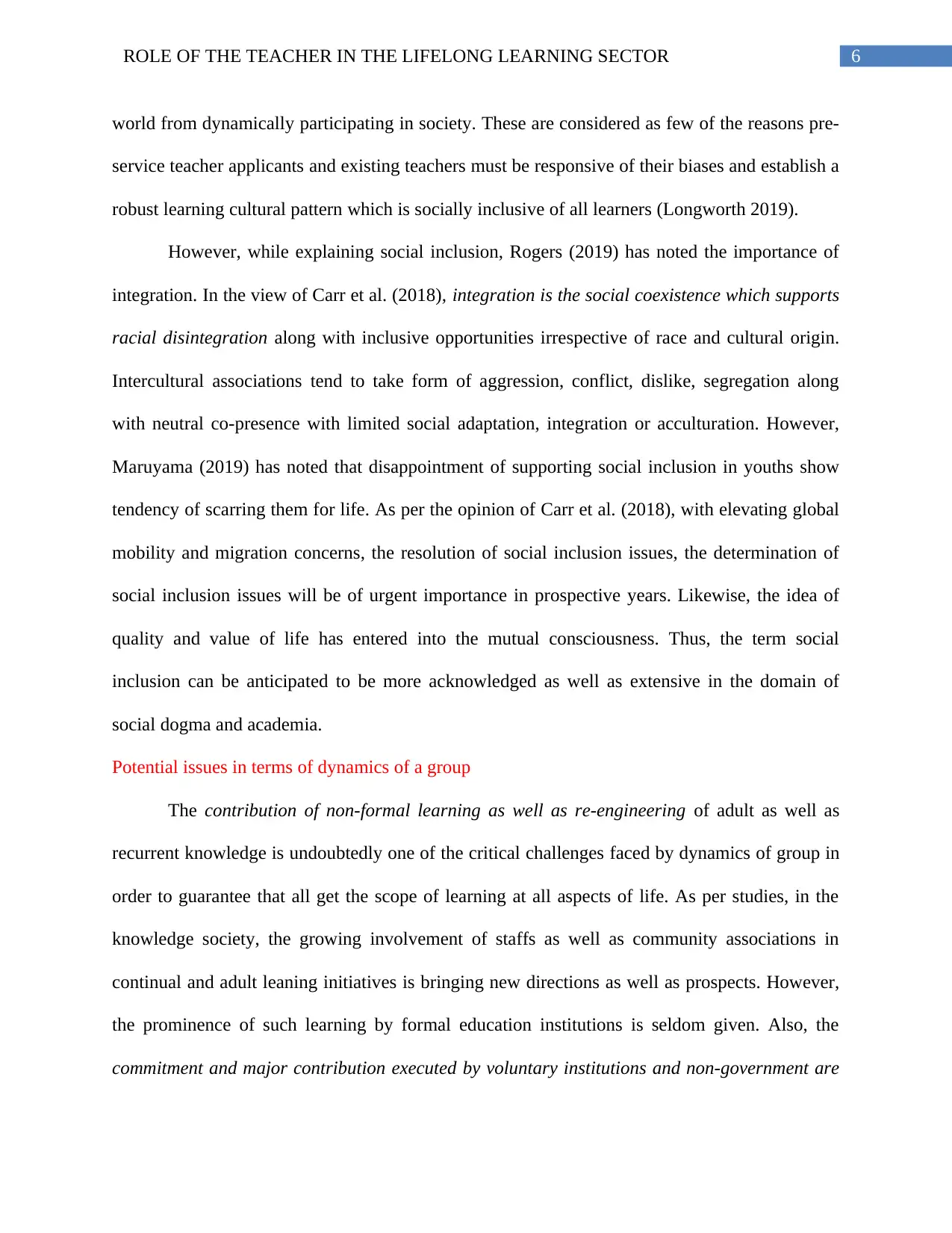
6ROLE OF THE TEACHER IN THE LIFELONG LEARNING SECTOR
world from dynamically participating in society. These are considered as few of the reasons pre-
service teacher applicants and existing teachers must be responsive of their biases and establish a
robust learning cultural pattern which is socially inclusive of all learners (Longworth 2019).
However, while explaining social inclusion, Rogers (2019) has noted the importance of
integration. In the view of Carr et al. (2018), integration is the social coexistence which supports
racial disintegration along with inclusive opportunities irrespective of race and cultural origin.
Intercultural associations tend to take form of aggression, conflict, dislike, segregation along
with neutral co-presence with limited social adaptation, integration or acculturation. However,
Maruyama (2019) has noted that disappointment of supporting social inclusion in youths show
tendency of scarring them for life. As per the opinion of Carr et al. (2018), with elevating global
mobility and migration concerns, the resolution of social inclusion issues, the determination of
social inclusion issues will be of urgent importance in prospective years. Likewise, the idea of
quality and value of life has entered into the mutual consciousness. Thus, the term social
inclusion can be anticipated to be more acknowledged as well as extensive in the domain of
social dogma and academia.
Potential issues in terms of dynamics of a group
The contribution of non-formal learning as well as re-engineering of adult as well as
recurrent knowledge is undoubtedly one of the critical challenges faced by dynamics of group in
order to guarantee that all get the scope of learning at all aspects of life. As per studies, in the
knowledge society, the growing involvement of staffs as well as community associations in
continual and adult leaning initiatives is bringing new directions as well as prospects. However,
the prominence of such learning by formal education institutions is seldom given. Also, the
commitment and major contribution executed by voluntary institutions and non-government are
world from dynamically participating in society. These are considered as few of the reasons pre-
service teacher applicants and existing teachers must be responsive of their biases and establish a
robust learning cultural pattern which is socially inclusive of all learners (Longworth 2019).
However, while explaining social inclusion, Rogers (2019) has noted the importance of
integration. In the view of Carr et al. (2018), integration is the social coexistence which supports
racial disintegration along with inclusive opportunities irrespective of race and cultural origin.
Intercultural associations tend to take form of aggression, conflict, dislike, segregation along
with neutral co-presence with limited social adaptation, integration or acculturation. However,
Maruyama (2019) has noted that disappointment of supporting social inclusion in youths show
tendency of scarring them for life. As per the opinion of Carr et al. (2018), with elevating global
mobility and migration concerns, the resolution of social inclusion issues, the determination of
social inclusion issues will be of urgent importance in prospective years. Likewise, the idea of
quality and value of life has entered into the mutual consciousness. Thus, the term social
inclusion can be anticipated to be more acknowledged as well as extensive in the domain of
social dogma and academia.
Potential issues in terms of dynamics of a group
The contribution of non-formal learning as well as re-engineering of adult as well as
recurrent knowledge is undoubtedly one of the critical challenges faced by dynamics of group in
order to guarantee that all get the scope of learning at all aspects of life. As per studies, in the
knowledge society, the growing involvement of staffs as well as community associations in
continual and adult leaning initiatives is bringing new directions as well as prospects. However,
the prominence of such learning by formal education institutions is seldom given. Also, the
commitment and major contribution executed by voluntary institutions and non-government are
Paraphrase This Document
Need a fresh take? Get an instant paraphrase of this document with our AI Paraphraser
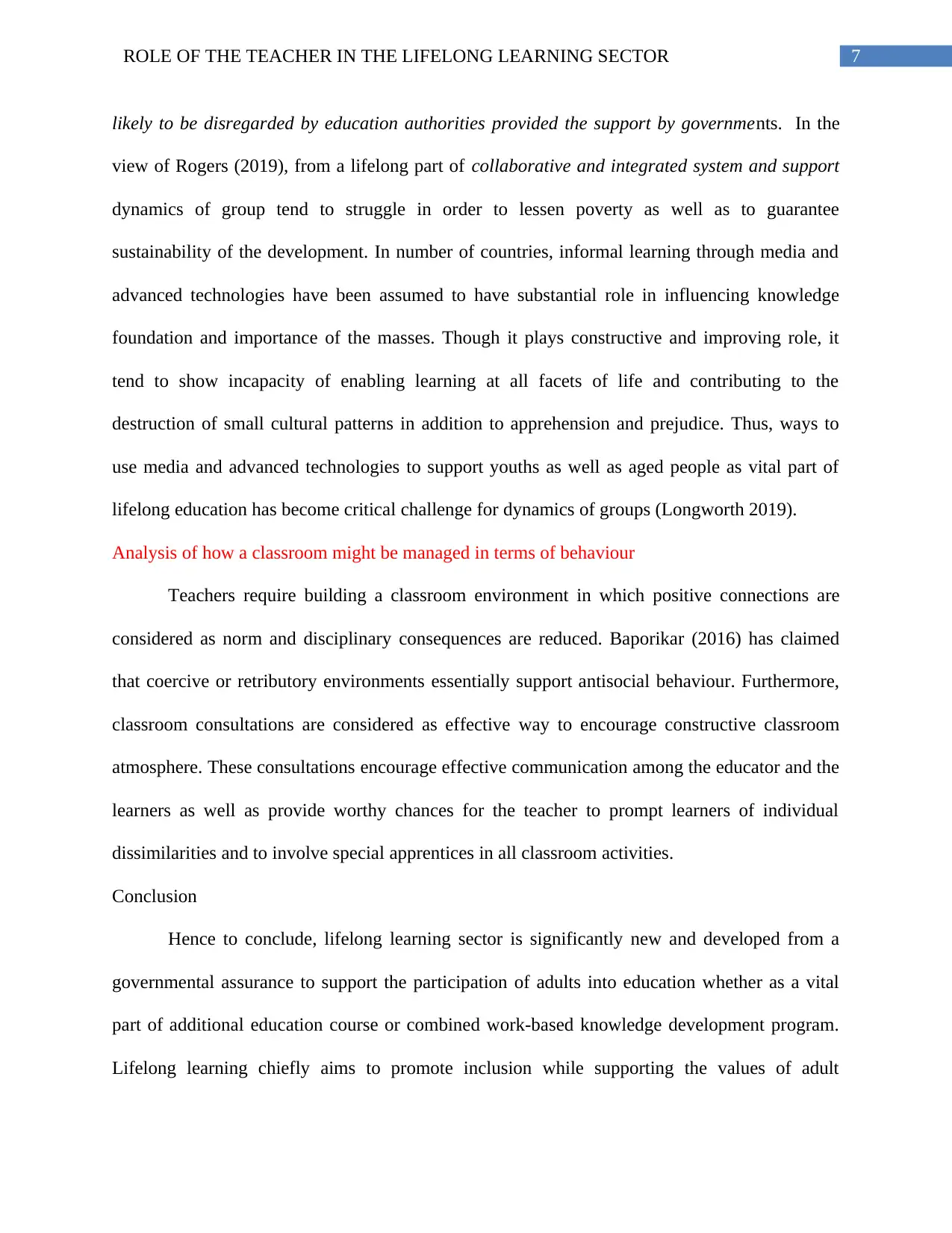
7ROLE OF THE TEACHER IN THE LIFELONG LEARNING SECTOR
likely to be disregarded by education authorities provided the support by governments. In the
view of Rogers (2019), from a lifelong part of collaborative and integrated system and support
dynamics of group tend to struggle in order to lessen poverty as well as to guarantee
sustainability of the development. In number of countries, informal learning through media and
advanced technologies have been assumed to have substantial role in influencing knowledge
foundation and importance of the masses. Though it plays constructive and improving role, it
tend to show incapacity of enabling learning at all facets of life and contributing to the
destruction of small cultural patterns in addition to apprehension and prejudice. Thus, ways to
use media and advanced technologies to support youths as well as aged people as vital part of
lifelong education has become critical challenge for dynamics of groups (Longworth 2019).
Analysis of how a classroom might be managed in terms of behaviour
Teachers require building a classroom environment in which positive connections are
considered as norm and disciplinary consequences are reduced. Baporikar (2016) has claimed
that coercive or retributory environments essentially support antisocial behaviour. Furthermore,
classroom consultations are considered as effective way to encourage constructive classroom
atmosphere. These consultations encourage effective communication among the educator and the
learners as well as provide worthy chances for the teacher to prompt learners of individual
dissimilarities and to involve special apprentices in all classroom activities.
Conclusion
Hence to conclude, lifelong learning sector is significantly new and developed from a
governmental assurance to support the participation of adults into education whether as a vital
part of additional education course or combined work-based knowledge development program.
Lifelong learning chiefly aims to promote inclusion while supporting the values of adult
likely to be disregarded by education authorities provided the support by governments. In the
view of Rogers (2019), from a lifelong part of collaborative and integrated system and support
dynamics of group tend to struggle in order to lessen poverty as well as to guarantee
sustainability of the development. In number of countries, informal learning through media and
advanced technologies have been assumed to have substantial role in influencing knowledge
foundation and importance of the masses. Though it plays constructive and improving role, it
tend to show incapacity of enabling learning at all facets of life and contributing to the
destruction of small cultural patterns in addition to apprehension and prejudice. Thus, ways to
use media and advanced technologies to support youths as well as aged people as vital part of
lifelong education has become critical challenge for dynamics of groups (Longworth 2019).
Analysis of how a classroom might be managed in terms of behaviour
Teachers require building a classroom environment in which positive connections are
considered as norm and disciplinary consequences are reduced. Baporikar (2016) has claimed
that coercive or retributory environments essentially support antisocial behaviour. Furthermore,
classroom consultations are considered as effective way to encourage constructive classroom
atmosphere. These consultations encourage effective communication among the educator and the
learners as well as provide worthy chances for the teacher to prompt learners of individual
dissimilarities and to involve special apprentices in all classroom activities.
Conclusion
Hence to conclude, lifelong learning sector is significantly new and developed from a
governmental assurance to support the participation of adults into education whether as a vital
part of additional education course or combined work-based knowledge development program.
Lifelong learning chiefly aims to promote inclusion while supporting the values of adult
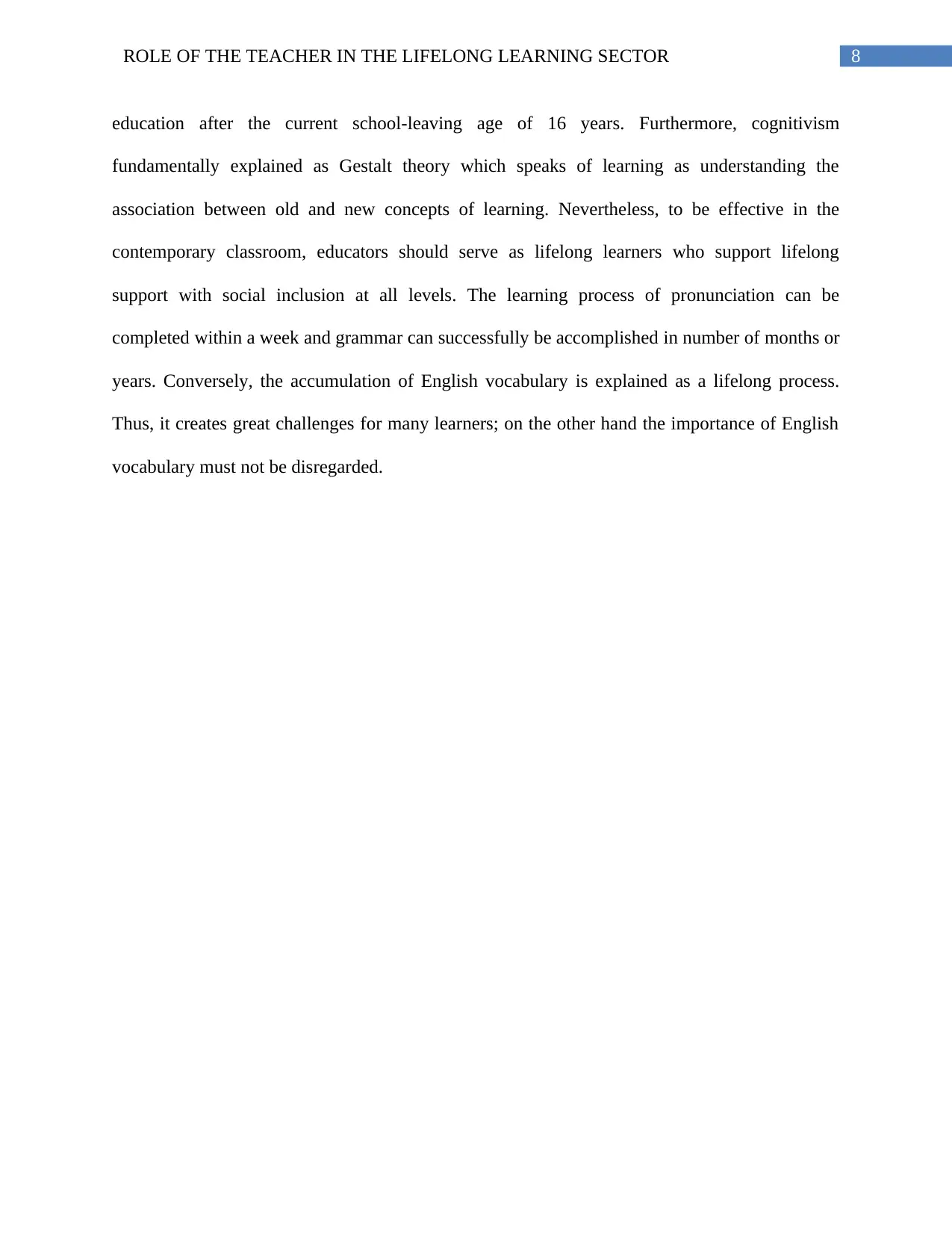
8ROLE OF THE TEACHER IN THE LIFELONG LEARNING SECTOR
education after the current school-leaving age of 16 years. Furthermore, cognitivism
fundamentally explained as Gestalt theory which speaks of learning as understanding the
association between old and new concepts of learning. Nevertheless, to be effective in the
contemporary classroom, educators should serve as lifelong learners who support lifelong
support with social inclusion at all levels. The learning process of pronunciation can be
completed within a week and grammar can successfully be accomplished in number of months or
years. Conversely, the accumulation of English vocabulary is explained as a lifelong process.
Thus, it creates great challenges for many learners; on the other hand the importance of English
vocabulary must not be disregarded.
education after the current school-leaving age of 16 years. Furthermore, cognitivism
fundamentally explained as Gestalt theory which speaks of learning as understanding the
association between old and new concepts of learning. Nevertheless, to be effective in the
contemporary classroom, educators should serve as lifelong learners who support lifelong
support with social inclusion at all levels. The learning process of pronunciation can be
completed within a week and grammar can successfully be accomplished in number of months or
years. Conversely, the accumulation of English vocabulary is explained as a lifelong process.
Thus, it creates great challenges for many learners; on the other hand the importance of English
vocabulary must not be disregarded.
⊘ This is a preview!⊘
Do you want full access?
Subscribe today to unlock all pages.

Trusted by 1+ million students worldwide
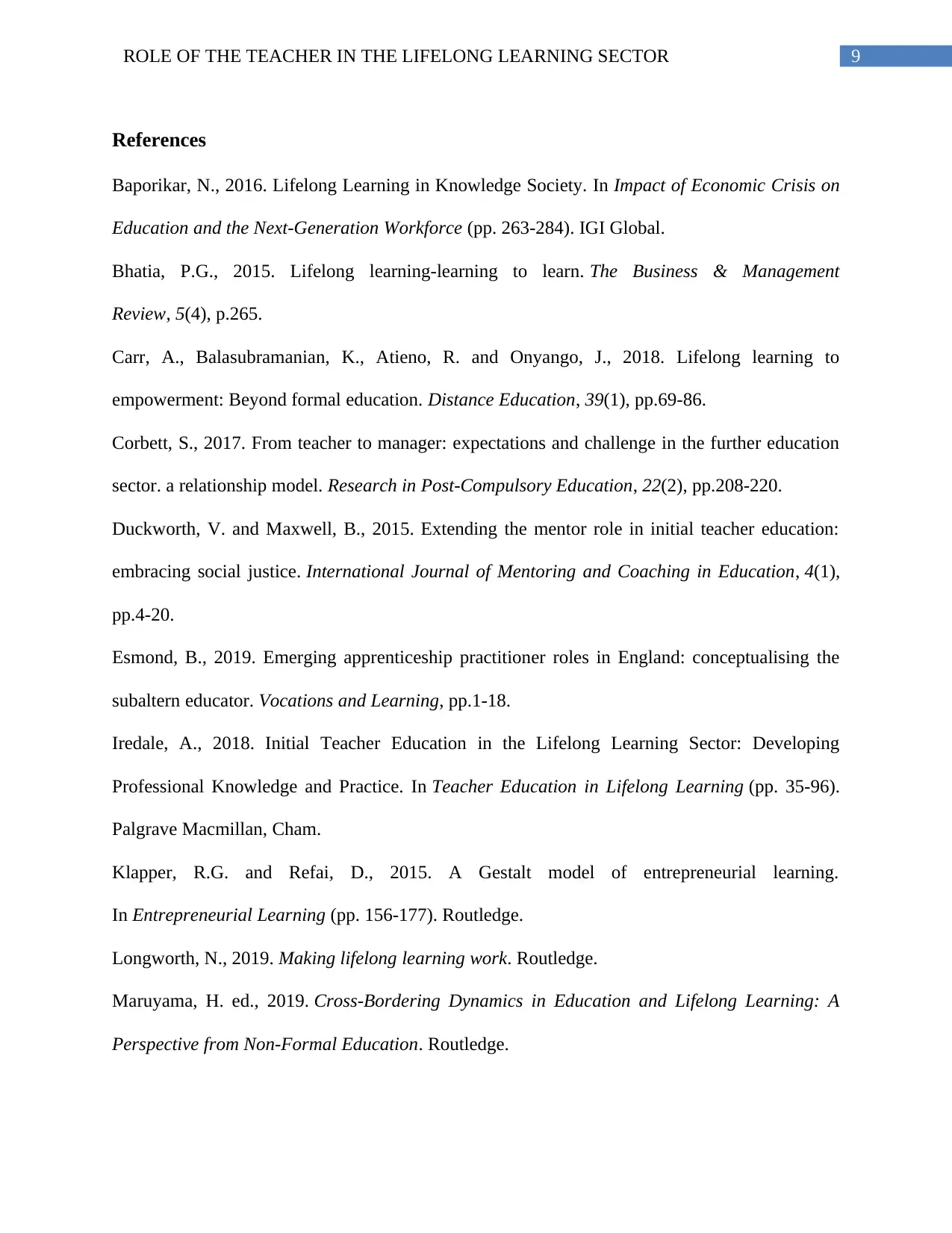
9ROLE OF THE TEACHER IN THE LIFELONG LEARNING SECTOR
References
Baporikar, N., 2016. Lifelong Learning in Knowledge Society. In Impact of Economic Crisis on
Education and the Next-Generation Workforce (pp. 263-284). IGI Global.
Bhatia, P.G., 2015. Lifelong learning-learning to learn. The Business & Management
Review, 5(4), p.265.
Carr, A., Balasubramanian, K., Atieno, R. and Onyango, J., 2018. Lifelong learning to
empowerment: Beyond formal education. Distance Education, 39(1), pp.69-86.
Corbett, S., 2017. From teacher to manager: expectations and challenge in the further education
sector. a relationship model. Research in Post-Compulsory Education, 22(2), pp.208-220.
Duckworth, V. and Maxwell, B., 2015. Extending the mentor role in initial teacher education:
embracing social justice. International Journal of Mentoring and Coaching in Education, 4(1),
pp.4-20.
Esmond, B., 2019. Emerging apprenticeship practitioner roles in England: conceptualising the
subaltern educator. Vocations and Learning, pp.1-18.
Iredale, A., 2018. Initial Teacher Education in the Lifelong Learning Sector: Developing
Professional Knowledge and Practice. In Teacher Education in Lifelong Learning (pp. 35-96).
Palgrave Macmillan, Cham.
Klapper, R.G. and Refai, D., 2015. A Gestalt model of entrepreneurial learning.
In Entrepreneurial Learning (pp. 156-177). Routledge.
Longworth, N., 2019. Making lifelong learning work. Routledge.
Maruyama, H. ed., 2019. Cross-Bordering Dynamics in Education and Lifelong Learning: A
Perspective from Non-Formal Education. Routledge.
References
Baporikar, N., 2016. Lifelong Learning in Knowledge Society. In Impact of Economic Crisis on
Education and the Next-Generation Workforce (pp. 263-284). IGI Global.
Bhatia, P.G., 2015. Lifelong learning-learning to learn. The Business & Management
Review, 5(4), p.265.
Carr, A., Balasubramanian, K., Atieno, R. and Onyango, J., 2018. Lifelong learning to
empowerment: Beyond formal education. Distance Education, 39(1), pp.69-86.
Corbett, S., 2017. From teacher to manager: expectations and challenge in the further education
sector. a relationship model. Research in Post-Compulsory Education, 22(2), pp.208-220.
Duckworth, V. and Maxwell, B., 2015. Extending the mentor role in initial teacher education:
embracing social justice. International Journal of Mentoring and Coaching in Education, 4(1),
pp.4-20.
Esmond, B., 2019. Emerging apprenticeship practitioner roles in England: conceptualising the
subaltern educator. Vocations and Learning, pp.1-18.
Iredale, A., 2018. Initial Teacher Education in the Lifelong Learning Sector: Developing
Professional Knowledge and Practice. In Teacher Education in Lifelong Learning (pp. 35-96).
Palgrave Macmillan, Cham.
Klapper, R.G. and Refai, D., 2015. A Gestalt model of entrepreneurial learning.
In Entrepreneurial Learning (pp. 156-177). Routledge.
Longworth, N., 2019. Making lifelong learning work. Routledge.
Maruyama, H. ed., 2019. Cross-Bordering Dynamics in Education and Lifelong Learning: A
Perspective from Non-Formal Education. Routledge.
Paraphrase This Document
Need a fresh take? Get an instant paraphrase of this document with our AI Paraphraser
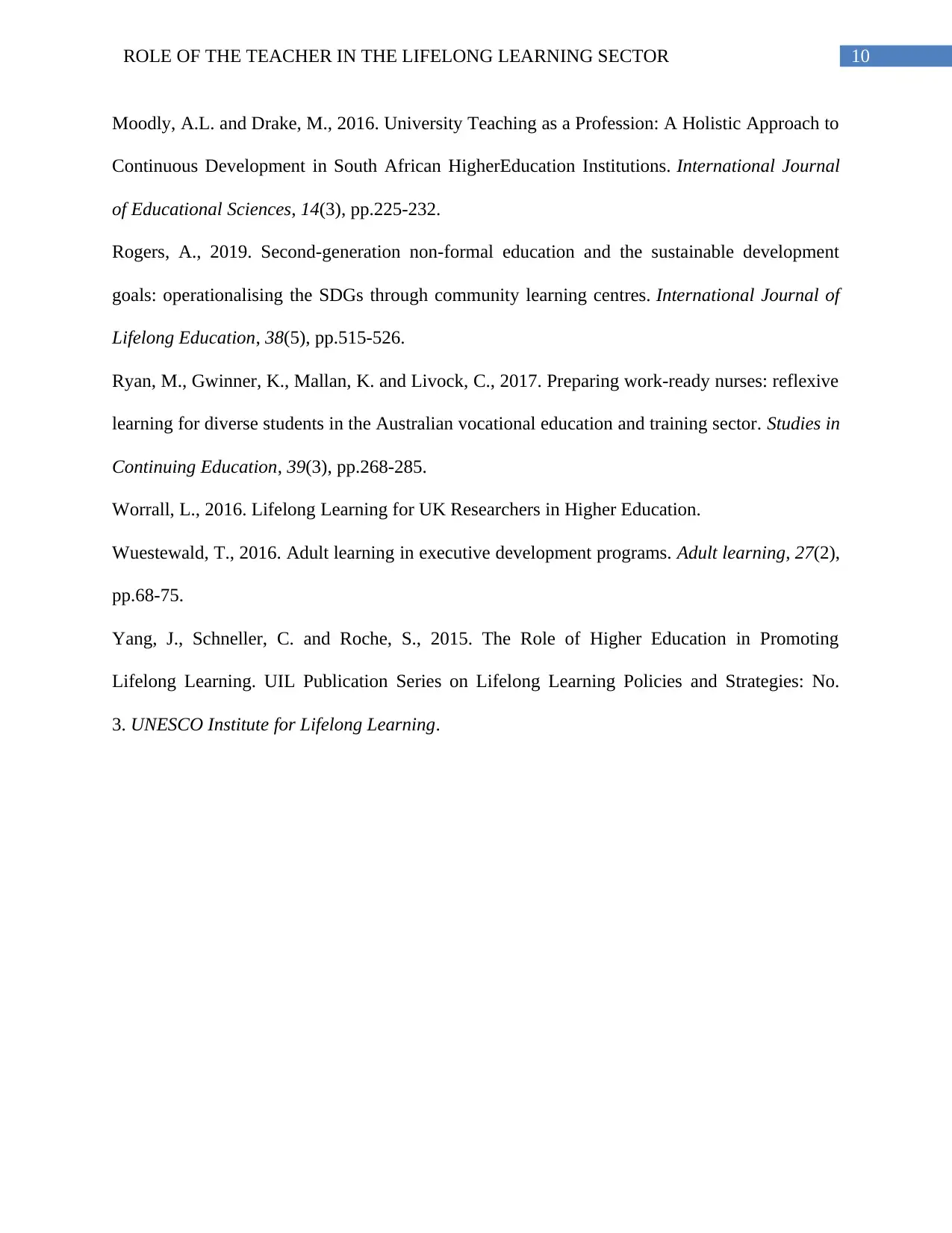
10ROLE OF THE TEACHER IN THE LIFELONG LEARNING SECTOR
Moodly, A.L. and Drake, M., 2016. University Teaching as a Profession: A Holistic Approach to
Continuous Development in South African HigherEducation Institutions. International Journal
of Educational Sciences, 14(3), pp.225-232.
Rogers, A., 2019. Second-generation non-formal education and the sustainable development
goals: operationalising the SDGs through community learning centres. International Journal of
Lifelong Education, 38(5), pp.515-526.
Ryan, M., Gwinner, K., Mallan, K. and Livock, C., 2017. Preparing work-ready nurses: reflexive
learning for diverse students in the Australian vocational education and training sector. Studies in
Continuing Education, 39(3), pp.268-285.
Worrall, L., 2016. Lifelong Learning for UK Researchers in Higher Education.
Wuestewald, T., 2016. Adult learning in executive development programs. Adult learning, 27(2),
pp.68-75.
Yang, J., Schneller, C. and Roche, S., 2015. The Role of Higher Education in Promoting
Lifelong Learning. UIL Publication Series on Lifelong Learning Policies and Strategies: No.
3. UNESCO Institute for Lifelong Learning.
Moodly, A.L. and Drake, M., 2016. University Teaching as a Profession: A Holistic Approach to
Continuous Development in South African HigherEducation Institutions. International Journal
of Educational Sciences, 14(3), pp.225-232.
Rogers, A., 2019. Second-generation non-formal education and the sustainable development
goals: operationalising the SDGs through community learning centres. International Journal of
Lifelong Education, 38(5), pp.515-526.
Ryan, M., Gwinner, K., Mallan, K. and Livock, C., 2017. Preparing work-ready nurses: reflexive
learning for diverse students in the Australian vocational education and training sector. Studies in
Continuing Education, 39(3), pp.268-285.
Worrall, L., 2016. Lifelong Learning for UK Researchers in Higher Education.
Wuestewald, T., 2016. Adult learning in executive development programs. Adult learning, 27(2),
pp.68-75.
Yang, J., Schneller, C. and Roche, S., 2015. The Role of Higher Education in Promoting
Lifelong Learning. UIL Publication Series on Lifelong Learning Policies and Strategies: No.
3. UNESCO Institute for Lifelong Learning.
1 out of 11
Related Documents
Your All-in-One AI-Powered Toolkit for Academic Success.
+13062052269
info@desklib.com
Available 24*7 on WhatsApp / Email
![[object Object]](/_next/static/media/star-bottom.7253800d.svg)
Unlock your academic potential
Copyright © 2020–2025 A2Z Services. All Rights Reserved. Developed and managed by ZUCOL.



